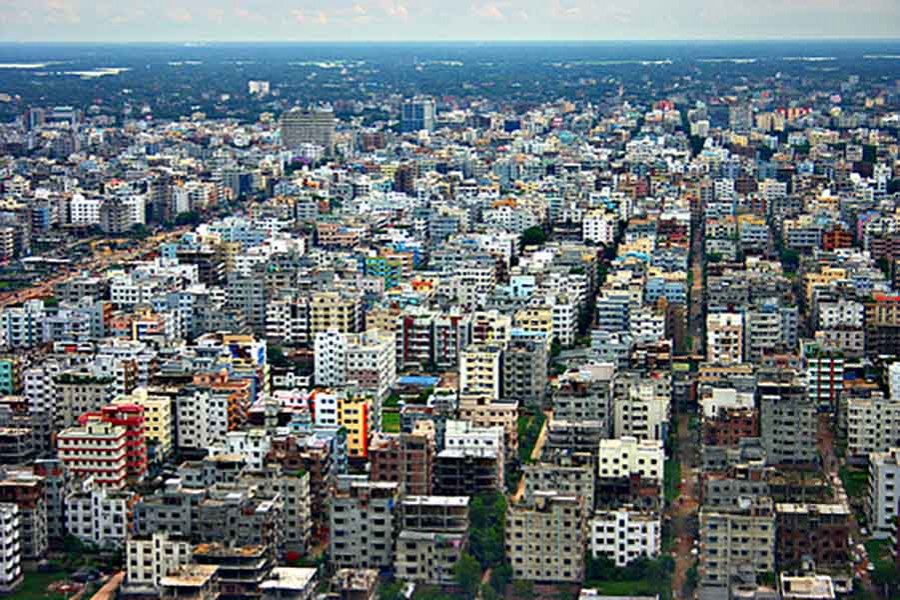Dhaka's ranking in the Economist Intelligence Unit's latest Global Liveability Index has dipped two notches down to 139th out of 140 cities surveyed. Its last but one position, however, corresponds to that of 2014 and 2015. Last year's position at 137th could not be retained. Syrian capital Damascus, like the previous year, takes the last slot. Given the on-going war with no security of life, the capital of that Middle-east country at least has the consolation that minus war it would have ranked far better. Dhaka has no excuse to advance for wallowing at the bottom for consecutive years. If the Bangladesh capital ranks this low without war, it is anybody's guess how exacerbated the living conditions here are.
Now what really has gone so terribly wrong that Dhaka offers next to no living conditions at all? Its infrastructure is found to be the main culprit. Its score on infrastructure is 26.8 -worst among all the countries surveyed. Even bottom-placed Damascus after having suffered years of bombardments from the government, rebels, multinational forces, scores 32.1 points on this count. Its nearest contender Algiers has a score of 30.4. This really presents a pathetic picture.
Dhaka's greatest problem is its unplanned growth together with near total lack of supervision and monitoring. Endemic official corruption and prevalence of muscle power together with the uncontrolled influence of the privileged have made a mockery of whatever plan there was to put the metropolis in at least some order. Imagine if the Bijoy Sarani and Pantha Path were not created then. The east-west connectivity within the city's central area would be simply non-existent. Notwithstanding those two roads' crafting, east-west commuting in the capital is still not straight and simple. The flyover from Kalshi, Mirpur serves the purpose well for people in that area.
The Economist Intelligence Unit has not placed Dhaka one slot above Damascus for nothing. Commuters here experience the intolerable tailbacks on a regular basis. If a half an hour's journey from residence to office takes two to three hours and equal or more time to return back, it does hardly any justice to living in a city. Waste of time and energy on way takes the spirit out of people doing office or other works. What is even worse is the lack of decent public transport. The ridesharing services have appeared as a real blessing but those are costly for the majority of the city dwellers using public transports.
One of the reasons is the lack of required road space. In a megalopolis like Dhaka, the road space should be at least 20 per cent but it has only about 8.0 per cent. Then the point most people miss is that this city has no metro rail, nor a large fleet of cheap taxis. The autos are not a decent mode of transportation and also these vehicles could not be regulated to use meter for fare.
If there is an all-round chaos in the transport sector, the distribution of population in city areas is grossly uneven. A survey showed recently that density of population in the city is far in excess of the carrying capacity or the tolerable limit. Whereas 150-200 people per acre is permissible, on an average more than 400 people live per acre in the city. Then the disparity in density is awfully wide with 175 people living per hectare in Gulshan and 2,746 people in Gendaria.
The indication is ominous. If Gulshan gives breathing space more than is required, areas like Gendaria teeming with people offer a whole mess of unhealthy living conditions. Dispersal of people all across the city is not possible because they live in houses that huddle together. There are worse instances, though, involving the settlements of slum people. Lacking in basic utility services, they lead a miserable life in unhygienic environment.
Dhaka has also lost points on poor condition of its inadequate roads that become water-logged frequently with mild to moderate rains. Its traffic jams then turn out to be nightmares for commuters. This is a consequence of improper use of lands for housing. Land developers and real estate companies have managed the housing authority to landfill where it is illegal and thus destroyed the water outlets and retention areas around the city. Even the rivers have been encroached upon to narrow and weaken their channels.
The list of mismanagement of city areas and its services is long. But it can be summed up as misgovernance. A city like this is bound to suffer culturally and it does. Its score on education in global terms is not satisfactory too. The city has literally gone into coma and if it is not urgently addressed, it will not take long to become dysfunctional altogether. The flyovers constructed at exorbitant costs did not bring about the expected relief, how the elevated express will take off the pressure is to be seen. But about one thing there is no doubt that this city must relieve of its population to some extent.
One of the solutions may be the shifting of the nation's administrative hubs to somewhere else -preferably to the proposed new town in Purbachal. At the same time, the programme of decentralisation has to be launched in order to arrest rush of people towards Dhaka from all corners of the country.


